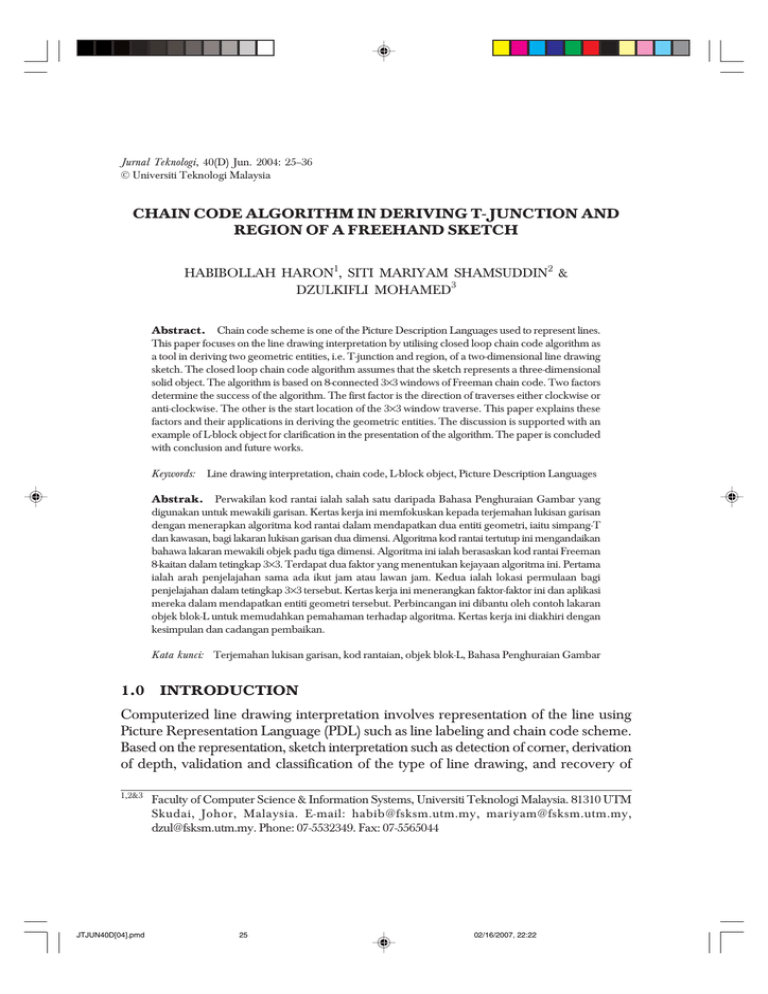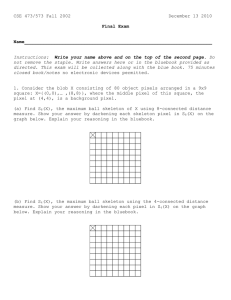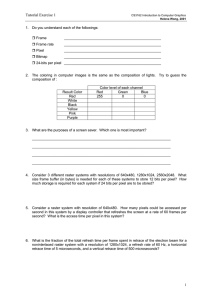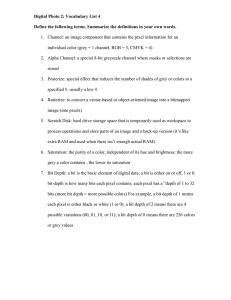CHAIN CODE ALGORITHM IN DERIVING T-JUNCTION AND HABIBOLLAH HARON
advertisement

CHAIN CODE ALGORITHM IN DERIVING T-JUNCTION AND REGION 25 Jurnal Teknologi, 40(D) Jun. 2004: 25–36 © Universiti Teknologi Malaysia CHAIN CODE ALGORITHM IN DERIVING T-JUNCTION AND REGION OF A FREEHAND SKETCH HABIBOLLAH HARON1, SITI MARIYAM SHAMSUDDIN2 & DZULKIFLI MOHAMED3 Abstract. Chain code scheme is one of the Picture Description Languages used to represent lines. This paper focuses on the line drawing interpretation by utilising closed loop chain code algorithm as a tool in deriving two geometric entities, i.e. T-junction and region, of a two-dimensional line drawing sketch. The closed loop chain code algorithm assumes that the sketch represents a three-dimensional solid object. The algorithm is based on 8-connected 3×3 windows of Freeman chain code. Two factors determine the success of the algorithm. The first factor is the direction of traverses either clockwise or anti-clockwise. The other is the start location of the 3×3 window traverse. This paper explains these factors and their applications in deriving the geometric entities. The discussion is supported with an example of L-block object for clarification in the presentation of the algorithm. The paper is concluded with conclusion and future works. Keywords: Line drawing interpretation, chain code, L-block object, Picture Description Languages Abstrak. Perwakilan kod rantai ialah salah satu daripada Bahasa Penghuraian Gambar yang digunakan untuk mewakili garisan. Kertas kerja ini memfokuskan kepada terjemahan lukisan garisan dengan menerapkan algoritma kod rantai dalam mendapatkan dua entiti geometri, iaitu simpang-T dan kawasan, bagi lakaran lukisan garisan dua dimensi. Algoritma kod rantai tertutup ini mengandaikan bahawa lakaran mewakili objek padu tiga dimensi. Algoritma ini ialah berasaskan kod rantai Freeman 8-kaitan dalam tetingkap 3×3. Terdapat dua faktor yang menentukan kejayaan algoritma ini. Pertama ialah arah penjelajahan sama ada ikut jam atau lawan jam. Kedua ialah lokasi permulaan bagi penjelajahan dalam tetingkap 3×3 tersebut. Kertas kerja ini menerangkan faktor-faktor ini dan aplikasi mereka dalam mendapatkan entiti geometri tersebut. Perbincangan ini dibantu oleh contoh lakaran objek blok-L untuk memudahkan pemahaman terhadap algoritma. Kertas kerja ini diakhiri dengan kesimpulan dan cadangan pembaikan. Kata kunci: Terjemahan lukisan garisan, kod rantaian, objek blok-L, Bahasa Penghuraian Gambar 1.0 INTRODUCTION Computerized line drawing interpretation involves representation of the line using Picture Representation Language (PDL) such as line labeling and chain code scheme. Based on the representation, sketch interpretation such as detection of corner, derivation of depth, validation and classification of the type of line drawing, and recovery of 1,2&3 JTJUN40D[04].pmd Faculty of Computer Science & Information Systems, Universiti Teknologi Malaysia. 81310 UTM Skudai, Johor, Malaysia. E-mail: habib@fsksm.utm.my, mariyam@fsksm.utm.my, dzul@fsksm.utm.my. Phone: 07-5532349. Fax: 07-5565044 25 02/16/2007, 22:22 26 HABIBOLLAH HARON, SITI MARIYAM SHAMSUDDIN & DZULKIFLI MOHAMED hidden parts can be carried out. This paper presents chain code as an input of the line drawing interpretation. Chain code scheme is a representation that consists of series of numbers. The numbers represent direction of the next pixel that can be used to represent shape and input format for numerous shape analysis algorithms. Since introduced by Freeman [1, 2], works on chain code in representing images, describing and recognizing shapes have been given consideration as an alternative method. Works on new scheme of chain code also have been proposed by Bribiesca [3, 4], Chen [5], Arrebola[6], O’Gorman[7], and Nunes [8], as well as techniques to compress the chain code by Choo [9]. In terms of application of chain code, Bribiesca [3, 10] used chain code to represent three-dimensional curve and surface coverage, Chen [5] used it to represent threedimensional curve. Choo [11] used chain code to represent polycurve, Livarinen [12], to recognize shape of irregular object, Pitas [13], to describe object, Arrebola [6,14], to detect corner and represent curve, Hanyu [15], to recognize object, and Maeder [16] used chain code in animation technique. They show that most applications of chain code are to represent curve and recognize shape of object because chain code allows reduction of data while preserving the information. Based on these works, we propose an enhanced chain code algorithm called closed loop chain code in representing a curve as an input in the line drawing interpretation and 3D object reconstruction. This paper is based on 8-connected chain code introduced by Freeman [1] in extracting geometric entities, namely, junctions, lines, and regions. This section explains previous works on chain code and its application in line drawing interpretation. Section 2 gives the definition of chain code. Sections 3 and 4 present the algorithm to extract the geometric entities in detail, supported by example for clarification. Section 5 discusses the results of the algorithm while Section 6 concludes this paper and presents the future works. Three assumptions have been made on this work. Firstly, the input image has already passed the digitization and thinning process. The details of the process can be referred in Haron [17]. Secondly, the two-dimensional line drawing represents a threedimensional object. Thirdly, the thinning process has removed all unwanted pixels. 2.0 CHAIN CODE Chain code is a list of codes ranging from 0 to 7 in clockwise direction. These codes represent direction of the next pixel connected in 3×3 windows as shown in Figure 1. For example, if a current pixel in an image is located at coordinate (5,5), the coordinate of the next pixel based on the chain code is given by Table 1. The coordinate of the next pixel is calculated based on the adding and subtraction of column and row by 1, depending on the value of chain code. This representation is based on work by Freeman chain code [2]. JTJUN40D[04].pmd 26 02/16/2007, 22:22 CHAIN CODE ALGORITHM IN DERIVING T-JUNCTION AND REGION Column-1 Column Column+1 row-1 5 6 7 row 4 (current pixel) 0 row+1 3 2 1 Figure 1 27 Location of chain code Table 1 Relation of pixel and chain code Current pixel at coordinate (5,5) Code Next row Next column 0 5 6 1 6 6 2 6 5 3 6 4 4 5 4 5 4 4 6 4 5 7 4 6 There are eight locations of pixels that surround the current pixel and they are represented by row and column. The chain code represents the direction of the next pixel. For example, in code 0, the direction of the next pixel is located at coordinate (row, column+1). Code –1 indicates that the current pixel is the last pixel in the list. 3.0 DERIVING T-JUNCTIONS This section discusses the algorithm to derive T-junctions with an example for better understanding. Figure 2 shows the actual image drawn using Adobe Photoshop in tiff format. It was assumed that the image was already thinned. Figure 3 shows the thinned binary image of Figure 2. The image is already modified by removing the ‘0’ pixel, and adding the column and row header for better understanding. The discussion in Section 3 and 4 is based on the pixel and their locations. In deriving the T-junctions, series of chain code represents boundary lines and internal lines that are derived in clockwise direction. The steps involved are given in Algorithm 1. JTJUN40D[04].pmd 27 02/16/2007, 22:22 28 HABIBOLLAH HARON, SITI MARIYAM SHAMSUDDIN & DZULKIFLI MOHAMED Figure 2 L-block size 100×100 Step 1: Traverse the thinned image. Assume start code is 0. Step 2: For the first pixel ‘1’ found; assign the location as current pixel. Start the clockwise search to find the next ‘1’ pixel. Table 2 shows the first start test location. Step 3: Change the pixel to ‘2’ to indicate that the location is already traversed. Put the code of the location in the series of the chain code. Assign this location as location of current pixel. Step 4: Move the location of current pixel to the next pixel found. Repeat step 2 until traverse back to the start pixel or when the pixel ‘2’ is found. Algorithm 1 Deriving T-junction Table 2 Start test location (clockwise direction) Previous code 0 1 2 3 4 5 6 7 Start test location 5 6 7 0 1 2 3 4 Based on the algorithm shown in Algorithm 1, T-junctions of thinned binary image shown in Figure 3 are searched. The steps taken are listed as follows: Step 1: Assume start code is 0. Step 2: The first pixel found is at location (7,38). From location (7,38) there are two pixels connected namely at location (8,37) and (7,39). By applying Table 2, since the previous code is 0, then the start test location is at code 5. From location (6,37), traverse the pixel in clockwise direction. Step 3: The next pixel found is at location (7,39) and the code is 0. The pixel is changed to number 2 to indicate that the pixel is already traversed. The current location is now changed to (7,39) and the current code is 0. JTJUN40D[04].pmd 28 02/16/2007, 22:22 CHAIN CODE ALGORITHM IN DERIVING T-JUNCTION AND REGION 29 00 234567890123456789123456789123456789123456789123456789123456789123456789123456789123456789000000000 00 00 023456789012345678901234567890123456789012345678901234567890123456789012345678901234567890123456789 00 60 111111111111111111111111111111111111111111111111111111111111111111111111111111111111111111111111111 60 70 111111111111111111111111111111111111111111111111111111111111111111111111111111111111111111111111111 70 80 111111111111111111111111111111111111111111111111111111111111111111111111111111111111111111111111111 80 90 111111111111111111111111111111111111111111111111111111111111111111111111111111111111111111111111111 90 10 111111111111111111111111111111111111111111111111111111111111111111111111111111111111111111111111111 10 11 111111111111111111111111111111111111111111111111111111111111111111111111111111111111111111111111111 11 12 111111111111111111111111111111111111111111111111111111111111111111111111111111111111111111111111111 12 13 111111111111111111111111111111111111111111111111111111111111111111111111111111111111111111111111111 13 14 111111111111111111111111111111111111111111111111111111111111111111111111111111111111111111111111111 14 15 111111111111111111111111111111111111111111111111111111111111111111111111111111111111111111111111111 15 16 111111111111111111111111111111111111111111111111111111111111111111111111111111111111111111111111111 16 17 111111111111111111111111111111111111111111111111111111111111111111111111111111111111111111111111111 17 18 111111111111111111111111111111111111111111111111111111111111111111111111111111111111111111111111111 18 19 111111111111111111111111111111111111111111111111111111111111111111111111111111111111111111111111111 19 20 111111111111111111111111111111111111111111111111111111111111111111111111111111111111111111111111111 20 21 111111111111111111111111111111111111111111111111111111111111111111111111111111111111111111111111111 21 22 111111111111111111111111111111111111111111111111111111111111111111111111111111111111111111111111111 22 23 111111111111111111111111111111111111111111111111111111111111111111111111111111111111111111111111111 23 24 111111111111111111111111111111111111111111111111111111111111111111111111111111111111111111111111111 24 25 111111111111111111111111111111111111111111111111111111111111111111111111111111111111111111111111111 25 26 111111111111111111111111111111111111111111111111111111111111111111111111111111111111111111111111111 26 27 111111111111111111111111111111111111111111111111111111111111111111111111111111111111111111111111111 27 28 111111111111111111111111111111111111111111111111111111111111111111111111111111111111111111111111111 28 29 111111111111111111111111111111111111111111111111111111111111111111111111111111111111111111111111111 29 30 111111111111111111111111111111111111111111111111111111111111111111111111111111111111111111111111111 30 31 111111111111111111111111111111111111111111111111111111111111111111111111111111111111111111111111111 31 32 111111111111111111111111111111111111111111111111111111111111111111111111111111111111111111111111111 32 33 111111111111111111111111111111111111111111111111111111111111111111111111111111111111111111111111111 33 34 111111111111111111111111111111111111111111111111111111111111111111111111111111111111111111111111111 34 35 111111111111111111111111111111111111111111111111111111111111111111111111111111111111111111111111111 35 36 111111111111111111111111111111111111111111111111111111111111111111111111111111111111111111111111111 36 37 111111111111111111111111111111111111111111111111111111111111111111111111111111111111111111111111111 37 38 111111111111111111111111111111111111111111111111111111111111111111111111111111111111111111111111111 38 39 111111111111111111111111111111111111111111111111111111111111111111111111111111111111111111111111111 39 40 111111111111111111111111111111111111111111111111111111111111111111111111111111111111111111111111111 40 41 111111111111111111111111111111111111111111111111111111111111111111111111111111111111111111111111111 41 42 111111111111111111111111111111111111111111111111111111111111111111111111111111111111111111111111111 42 43 111111111111111111111111111111111111111111111111111111111111111111111111111111111111111111111111111 43 44 111111111111111111111111111111111111111111111111111111111111111111111111111111111111111111111111111 44 45 111111111111111111111111111111111111111111111111111111111111111111111111111111111111111111111111111 45 46 111111111111111111111111111111111111111111111111111111111111111111111111111111111111111111111111111 46 47 111111111111111111111111111111111111111111111111111111111111111111111111111111111111111111111111111 47 48 111111111111111111111111111111111111111111111111111111111111111111111111111111111111111111111111111 48 49 111111111111111111111111111111111111111111111111111111111111111111111111111111111111111111111111111 49 50 111111111111111111111111111111111111111111111111111111111111111111111111111111111111111111111111111 50 51 111111111111111111111111111111111111111111111111111111111111111111111111111111111111111111111111111 51 52 111111111111111111111111111111111111111111111111111111111111111111111111111111111111111111111111111 52 53 111111111111111111111111111111111111111111111111111111111111111111111111111111111111111111111111111 53 54 111111111111111111111111111111111111111111111111111111111111111111111111111111111111111111111111111 54 55 111111111111111111111111111111111111111111111111111111111111111111111111111111111111111111111111111 55 56 111111111111111111111111111111111111111111111111111111111111111111111111111111111111111111111111111 56 57 111111111111111111111111111111111111111111111111111111111111111111111111111111111111111111111111111 57 58 111111111111111111111111111111111111111111111111111111111111111111111111111111111111111111111111111 58 59 111111111111111111111111111111111111111111111111111111111111111111111111111111111111111111111111111 59 60 111111111111111111111111111111111111111111111111111111111111111111111111111111111111111111111111111 60 61 111111111111111111111111111111111111111111111111111111111111111111111111111111111111111111111111111 61 62 111111111111111111111111111111111111111111111111111111111111111111111111111111111111111111111111111 62 63 111111111111111111111111111111111111111111111111111111111111111111111111111111111111111111111111111 63 64 111111111111111111111111111111111111111111111111111111111111111111111111111111111111111111111111111 64 65 111111111111111111111111111111111111111111111111111111111111111111111111111111111111111111111111111 65 66 111111111111111111111111111111111111111111111111111111111111111111111111111111111111111111111111111 66 67 111111111111111111111111111111111111111111111111111111111111111111111111111111111111111111111111111 67 68 111111111111111111111111111111111111111111111111111111111111111111111111111111111111111111111111111 68 69 111111111111111111111111111111111111111111111111111111111111111111111111111111111111111111111111111 69 70 111111111111111111111111111111111111111111111111111111111111111111111111111111111111111111111111111 70 71 111111111111111111111111111111111111111111111111111111111111111111111111111111111111111111111111111 71 72 111111111111111111111111111111111111111111111111111111111111111111111111111111111111111111111111111 72 73 111111111111111111111111111111111111111111111111111111111111111111111111111111111111111111111111111 73 74 111111111111111111111111111111111111111111111111111111111111111111111111111111111111111111111111111 74 75 111111111111111111111111111111111111111111111111111111111111111111111111111111111111111111111111111 75 76 111111111111111111111111111111111111111111111111111111111111111111111111111111111111111111111111111 76 77 111111111111111111111111111111111111111111111111111111111111111111111111111111111111111111111111111 77 78 111111111111111111111111111111111111111111111111111111111111111111111111111111111111111111111111111 78 79 111111111111111111111111111111111111111111111111111111111111111111111111111111111111111111111111111 79 80 111111111111111111111111111111111111111111111111111111111111111111111111111111111111111111111111111 80 81 111111111111111111111111111111111111111111111111111111111111111111111111111111111111111111111111111 81 82 111111111111111111111111111111111111111111111111111111111111111111111111111111111111111111111111111 82 83 111111111111111111111111111111111111111111111111111111111111111111111111111111111111111111111111111 83 84 111111111111111111111111111111111111111111111111111111111111111111111111111111111111111111111111111 84 85 111111111111111111111111111111111111111111111111111111111111111111111111111111111111111111111111111 85 86 111111111111111111111111111111111111111111111111111111111111111111111111111111111111111111111111111 86 87 111111111111111111111111111111111111111111111111111111111111111111111111111111111111111111111111111 87 88 111111111111111111111111111111111111111111111111111111111111111111111111111111111111111111111111111 88 89 111111111111111111111111111111111111111111111111111111111111111111111111111111111111111111111111111 89 90 111111111111111111111111111111111111111111111111111111111111111111111111111111111111111111111111111 90 91 111111111111111111111111111111111111111111111111111111111111111111111111111111111111111111111111111 91 92 111111111111111111111111111111111111111111111111111111111111111111111111111111111111111111111111111 92 93 111111111111111111111111111111111111111111111111111111111111111111111111111111111111111111111111111 93 023456789012345678901234567890123456789012345678901234567890123456789012345678901234567890123456789 Figure 3 JTJUN40D[04].pmd 29 Raw image of Figure 2 after thinning process 02/16/2007, 22:22 30 HABIBOLLAH HARON, SITI MARIYAM SHAMSUDDIN & DZULKIFLI MOHAMED Step 4: This process is repeated until the location is back to the start location i.e. at (7,38). The first chain code series in Figure 4 shows the chain code of the boundary. The process is repeated to find the internal line. After the traversal of boundary line is finished, the first ‘1’ pixel found is at location (28,13) and the start code is 0. Starting from this location, the traversal process is continued until pixel ‘2’ is found or there is no more pixels to be traversed. The second chain code series in Figure 4 shows the chain code of the first internal line starting from location (28,13) and ending at location (48,82). The process is repeated until no more ‘1’ pixel is found. The third, fourth, and fifth series of chain code in Figure 4, which started from location (49,48), (56,31), and (61,69) respectively, represent the vertical internal line of the L-block. The algorithm produces a series of chain code. The first one actually represents the border of the image while the rest of the series represent the internal line of the line. Figure 4 shows the complete chain code series. Using the chain code series in Figure 4, T-junction of the image can be obtained by finding intersection of boundary chain code and internal chain code. There are two types of T-junction which are located on the boundary line and internal line. T-junction on boundary is derived first, followed by T-junction on internal line. For every coordinate in the boundary chain code, the coordinates are compared to the first and last record of all internal line chain code. If a current boundary coordinate is adjacent to those records, then the boundary coordinate will be assigned as T-junction. Comparing all coordinates in the current internal line chain code will derive Tjunction on internal line. These values are compared to the first and last records of the Chain Code : Boundary and Internal Line Start From (7, 38) 0 0 1111 0 1 0 1 0 11 0 1 0 11 0 11 0 111 0 111 0 11111111 2 2 111111 2 1 2 2 1112222222221222222222222223233332333332333334443454 5555455455555555453434343433334344534455556555656565 5665566555656665666666666666666666666666777566677000 077077707777707707700-1 Start From (28,13) 1121121212121211211211121110070707077077700010000101011 011111110107077777777777-1 Start From (49,48) 22222222222222232222222222-1 Start From (56,31) 322222222222222222222222222-1 Start From (61,69) 22222222222222222222222222222-1 Figure 4 Chain code of boundary and internal line of L-block Figure 3 JTJUN40D[04].pmd 30 02/16/2007, 22:22 CHAIN CODE ALGORITHM IN DERIVING T-JUNCTION AND REGION 31 rest of the internal line chain code. If adjacent coordinate is found, then the T-junction is found. Figure 5 shows the list of T-junctions found where PntType is equal to 3 which indicates that the junction is located on the boundary line while 99 indicates that the point is not on the boundary. Row === 47 91 76 84 28 55 48 60 Col === 84 70 47 30 12 31 49 69 PntNo ===== 0 1 2 3 4 5 6 7 PntType ====== 0 3 0 3 0 3 0 3 0 3 99 99 99 Figure 5 T-Junction table of L-block Figure 3 4.0 DERIVING REGIONS In deriving chain code for the region, again there is a need to traverse the image from the location (0,0) and use the junction table that has just been derived. Besides, there is also a need to create a new chain code for each region. The traversal of the image is similar to the traversal of deriving T-junction except in the determination of the first test location and the direction of pixel searching. Table 3 shows the start test location. The start location is different compared to Table 2. The direction of the traversal is also in the opposite way namely in anti-clockwise direction. There are two functions of the junction table in deriving the region. The first function is to determine the number of region in the image and the other is to provide the start location of the traversal. Algorithm 2 shows the deriving region algorithm. Table 3 Start test location (anti-clockwise direction) Previous code 0 1 2 3 4 5 6 7 Start test location 3 4 5 6 7 0 1 2 The explanation of Algorithm 2 is based on the binary thinned image of Figure 3. The steps taken are as follows: Step 1: In the second series of region code (Figure 6), location (91,70) is the second junction of the junction table. The next consecutive junction is at location (76,47). The chain codes between these junctions are copied into the region series. JTJUN40D[04].pmd 31 02/16/2007, 22:22 32 HABIBOLLAH HARON, SITI MARIYAM SHAMSUDDIN & DZULKIFLI MOHAMED Step 1: For every T-junction, the record of chain code between the Tjunction and the next consecutive T-junction is copied into region chain code. Step 2: Starting from the next consecutive T-junction, the connected pixel in the window 3×3 is determined using the previous location code of the current pixel as shown in Table 3. Step 3: Starting from the start location, the window is traversed in anticlockwise direction to find the next connected pixel. Change the pixel to ‘2’ to indicate that the location is already traversed. Put the code of the location in the series of the region chain code. Step 4: Move the location 0 current pixel to the next pixel found. Repeat step 2 until the traversal find pixel ‘2’. Algorithm 2 Deriving region Region chain code now contains the chain code from location (91,70) till (76,47). These chain codes are also part of the first chain code in Figure 4. Step 2: From location (76,47), the start test location is based on the previous code (refer Table 3). Since the previous code is 5, then the start test location is at code 0. Step 3: By searching in anti-clockwise direction, the first ‘1’ pixel found is at location (75,47) or at code 6. The pixel is changed to ‘2’. Step 4: The current location pixel is changed to the location (75,47) and the region chain code is added by the code 6. This process is repeated until the traversal back to location (91,70), i.e. the pixel 2 is found. Figure 6 shows the series of chain code produced for region searching. There are five junctions on the boundary, namely at location (47,84), (91,70), (76,47), (84,30), and (28,12). Therefore, there are five series of region chain code derived from the traversal, as shown in Figure 6. Based on the region chain code, location of each code will be compared to the junction list. If the location of the code is a junction, then the junction will be added in the list of junctions bounding the region. Algorithm 3 shows the algorithm to create region table. For example, the first region is bounded from three junctions namely junction 0, 1, and 7. Junction 7 is added in the list of point in region by comparing the location of the code and the junction table. Figure 7 shows the region table corresponding to the chain code of Figure 6. Note that the order of start junction of each region is based on the sequence of the T-junction. Note also that there is one corner between location (47,84) and location (91,70). The searching of this kind of junction is beyond our discussion and can be referred in Haron [17]. The algorithm is tested on the thinned image of the L-block (Figure 3). Figure 8 shows the corresponding label of the junction and region derived. There are five T- JTJUN40D[04].pmd 32 02/16/2007, 22:22 CHAIN CODE ALGORITHM IN DERIVING T-JUNCTION AND REGION CHAIN CODE : REGION Start From (47,84) 1122222222212222222222222232333323333323333344566666 66666666666666666666666677077777777777-1 Start From (91,70) 434545555455455555555456666666666676666666666666667 00001010110111111101222222222222222222222222222222-1 Start From (76,47) 343434343333434456666666666666666666666666667707070 707707770001322222222222222232222222222-1 Start From (84,30) 344555565556565655665566555656665666666666666666666 66666677701121121212121211211211121112322222222222222 222222222222-1 Start From (28,12) 56667700007707770777770770770000111101010110101101 10111011101111111122111111212213333333333334345455555 55455454544445444333433434343445556555655655656565656 55655-1 Figure 6 Region code of L-block Figure 3 for every region chain code series for every coordinate in the chain code series if the coordinate match with the coordinate in junction table, add the junction in the list of junction that bounded the region. endif endfor endfor Algorithm 3 Region creation List of Point in Region 0: List of Point in Region 1: List of Point in Region 2: List of Point in Region 3: List of Point in Region 4: 0 1 2 3 4 1 2 3 4 0 7 6 5 5 7 7 6 6 Figure 7 Region table of L-block Figure 3 JTJUN40D[04].pmd 33 02/16/2007, 22:22 5 33 34 HABIBOLLAH HARON, SITI MARIYAM SHAMSUDDIN & DZULKIFLI MOHAMED P4 R4 P5 R3 P6 P0 P7 R0 P2 P3 R2 Figure 8 R1 P1 L-block with label junctions extracted and they are labeled as P0, P1, P2, P3, and P4. There are five regions extracted and they are labeled as R0, R1, R2, R3, and R4. 5.0 DISCUSSION ON RESULTS Results show that the list of points labeled as P1, P2, P3, P4, P5, P6, and P7 shown in Figure 8 have been derived exactly as intended in the sketch. The list of points as shown in Figure 7 that bounded all three regions which are labeled as R1, R2, and R3 in Figure 8 have also been derived exactly as intended in the sketch. The junction derivation employed in this paper can be compared to the constraint enforcement employed by Jenkins and Martin [18] of the system called Easel. The proposed constraint enforcement algorithm has been used by Grimstead [19] to derive junctions in his sketch interpretation. The L-block as shown in Figure 9 used by Grimstead [19], is used to compare the results. In terms of the number and coordinate of T-junctions, similar result has been derived. The comparison in terms of processing time taken and accuracy of the coordinate are beyond the scope of this study. L-b loc k Figure 9 L-block Grimstead[19] JTJUN40D[04].pmd 34 02/16/2007, 22:22 CHAIN CODE ALGORITHM IN DERIVING T-JUNCTION AND REGION 6.0 35 CONCLUSION & FUTURE WORKS This paper shows that chain code can be used to derive geometry entities of a line drawing. The simple way to find T-junction which is by applying the principle that intersection of two lines will produce T-junction, which is applied in this work. Two algorithms have been produced to show the significance of direction of traversal in deriving chain code. The start of test location proposed in this work is capable of avoiding the traversal from missing any region or breaking the continuity of any lines. The searching of corner or V-junction between T-junction must be carried out so that the region will produce the correct shape as in the original image. The algorithm of corner detection of the chain code can be referred to Haron [17]. The chain code can also be used as input in line drawing interpretation and line labeling algorithm. REFERENCES [1] [2] [3] [4] [5] [6] [7] [8] [9] [10] [11] [12] [13] [14] [15] [16] [17] [18] [19] JTJUN40D[04].pmd Freeman, H. 1974. Computer Processing of Line Drawing Images. Computing Surveys. 6(1): 57-97. Freeman. H. 1961. On the Encoding of Arbitrary Geometric Configurations. IRE Trans. Electron. Comp. EC-10: 260-268. Bribiesca, E. 2000. A Chain Code for Representing 3D Curves. Pattern Recognition. 33: 755-765. Bribiesca, E. 1999. A New Chain Code, Pattern Recognition. 32: 235-251. Chen, Y. W., S. C. Lee, 1991. The C-chain Code – A New Method for Coding 3D Curves. Proceedings of Asimolar Conference on Signals, Systems & Computers. Part 1(of 2): 472-476. Arrebola, F., A. Bandera, P. Camacho., and F. Sandoval. 1997. Corner Detection by Local Histograms of Contour Chain Code. Electronics Letters. 33(21): 1769-1771. O’Gorman, L. 1988. Primitives Chain Code. International Conference on Acoustics, Speech, and Signal Processing. ICASSP-88. 2: 792-795. Nunes, P., F. Pereira., and F. Marques. 1997. Multi-Grid Chain Coding of Binary Shapes. Proc. Of Int. Conf. On Image Processing. 3: 114-117, 26-29. Choo, C. Y., and H. Freeman. 1992. An Efficient Technique for Compressing Chain-coded Line Drawing Images. Proceedings Conference on 26th Asimolar Conference on Signals, Systems and Computers. 2: 717-720. Bribiesca, E. 2003. Scanning-curves Representation for the Coverage of Surfaces Using Chain Code. Computer & Graphics. 27(1): 123-132. Choo, C. Y. 1986. Line Drawing Representation Using The Polycurve Code (Chain Code). PhD Thesis. Rensselaer Polytechnic Institute. U.S.A. Livarinen, J. 1996. Shape Recognition of Irregular Objects. Proceedings of SPIE-The International Society for Optical Engineering. 2904: 25-32. Pitas, I. 1995. Digital Image Processing Algorithm. University Press Cambridge: Prentice Hall. Arrebola, F., A., Bandera., P. Camacho., and F. Sandoval. 1999. Corner Detection and Curve Representation by Circular Histograms of Contour Chain Code. Electronics Letters. 35(13): 1065-1067. Hanyu, T., S. Choi, M. Kameyama., and T. Higuchi. 1993. 3-D Object Recognition System Based on 2-D Chain Code Matching. IEICE Trans. On Fundamentals of Electronics, Communications and Computer Sciences. V E76-A n 6: 97-923. Maeder, A. J. 1990. Animation Techniques for Chain-coded Objects. Proc. Of First IEEE Conf. On Visualization. 67-73. Haron, H., D. Mohamed., and S. M. Shamsuddin. 2003. Extraction of Junctions, Lines and Regions of Irregular Line Drawing: The Chain Code Processing Algorithm. Jurnal Teknologi. 38 (D): 1-28. Jenkins, D. L., and R. R. Martin. 1992. Applying Constraints to Enforce Users’ Intentions in Freehand 2D Sketches. Intelligent Systems Engineering. 1(1): 32-49. Grimstead, I. J. 1997. Interactive Sketch Input of Boundary Representation Solid Models. PhD Thesis. Univ. of Cardiff. U.K. 35 02/16/2007, 22:22




